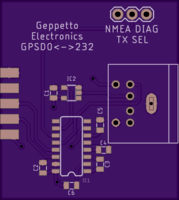GPSDO<->232
author: nsayer
2 layer board of 1.25 x 1.40 inches (31.8 x 35.6 mm)
Uploaded:
December 24, 2017
Shared:
December 24, 2017
Total Price:
$8.75
This board adapts the GPSDO diagnostic port to RS-232. You get to select whether to transmit the diagnostic output or the GPS NMEA output. PPS is sent to DCD, and is positive-oriented (that is, DCD asserts on-time).
The SOIC-16 chip is a MAX232. The SOT23-5 is a single inverter. All 6 caps are 0.1 µF. The edge-mounted DB9 should be a female. It can connect directly to a DB9M style serial port or cable. The diagnostic connector is a CUI MD60S. You use a straight-through mini-DIN-6 cable (like a PS/2 cable) to connect up to the GPSDO.
For maximum stability, you should keep this board connected permanently if you’re going to use it. Adding and removing powered loads on the diagnostic connector can have a short term stability impact.
This board adapts the GPSDO diagnostic port to RS-232. You get to select whether to transmit the diagnostic output or the GPS NMEA output. PPS is sent to DCD, and is positive-oriented (that is, DCD asserts on-time).
The SOIC-16 chip is a MAX232. The SOT23-5 is a single inverter. All 6 caps are 0.1 µF. The edge-mounted DB9 should be a female. It can connect directly to a DB9M style serial port or cable. The diagnostic connector is a CUI MD60S. You use a straight-through mini-DIN-6 cable (like a PS/2 cable) to connect up to the GPSDO.
For maximum stability, you should keep this board connected permanently if you’re going to use it. Adding and removing powered loads on the diagnostic connector can have a short term stability impact.

